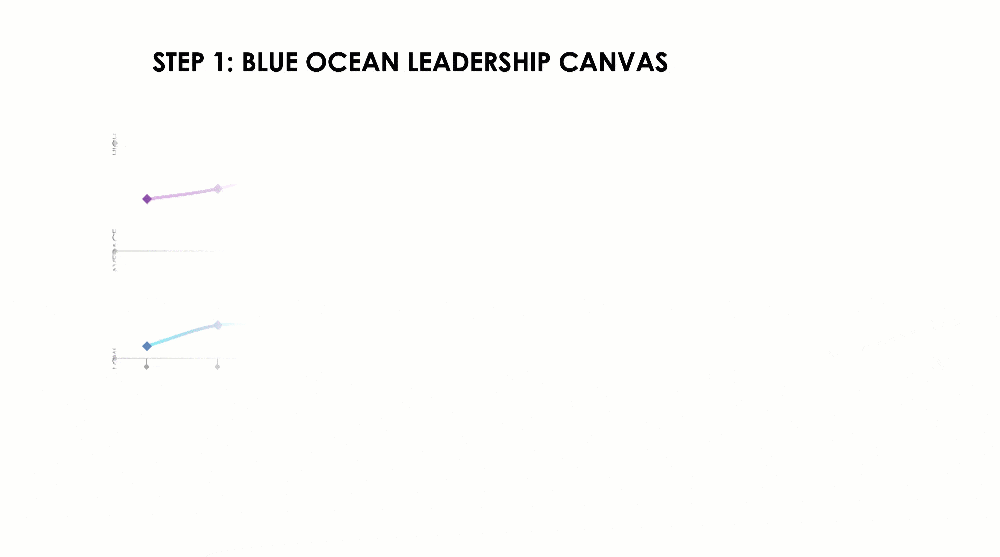Synopsis
Your competition is fierce and you can't outspend or outperform them at what they already do best. So how do you stand out? Create uncontested market space and make your competition irrelevant with Blue Ocean Strategy. Blue Ocean Strategy helps build a product that's innovative, profitable, and untouchable by your competition.
Slide highlights
Learn the Blue Ocean Shift Process to start from where you are now, imagine where you could be, discover how to get there, and make your move. (Slide 6)
Use a Buyer Utility Map to plot how your Blue Ocean offering stacks up against the current focus of your industry. (Slide 9)
Move your organization's mindset beyond value limitations and towards value innovation for your customers. (Slide 16)
Outcome
Before there was Ford, there was no market for automobiles – because the competition was horses. Before Apple created iTunes, no one bought individual mp3 tracks over CDs. Before Uber, no one clicked a button to have a stranger pick them up.
While "disruption" has become a buzzword, the concept of value innovation is the secret ingredient used by legendary favorites across different industries. Competing in a crowded and over-saturated Red Ocean only maintains your status quo, and is probably costly and futile. Instead, dive into a Blue Ocean to create your own market space, with products that align innovation, price, utility, and cost.
Application
Introduction
Blue Ocean Strategy was conceptualized based on studies of company success and failure in more than 30 industries over 10 years. The study revealed companies that go after markets with high profit potential and less competition are the most successful. Blue Ocean Strategy is the framework to pursue both differentiation and low cost to open a new market with new demands. (Slide 2)
Six principles
There are six principles of Blue Ocean Strategy, each with key tools and objectives. Each principle comes with its own set of risks. For instance, Blue Ocean Strategy operates under the belief that boundaries and industry structures can be reconstructed based on the actions of the players involved. So under this first principle, reconstruct market boundaries, your company could face a "search risk". The "search risk" comes from the need to educate your customer base about the new market that's been created. (Slide 4)
Value innovation
The concept of value innovation is crucial to Blue Ocean Strategy. For traditional companies, their key value proposition meets at the intersection of price and product or feature value. For value innovation to occur, however, you need to focus on the big picture, not the numbers. Discover which factors your industry has long competed on that should be eliminated, and explore which factors should be created that the industry has yet offered. (Slide 5)
Strategic sequence
Get the strategic sequence right to create a commercially viable blue ocean idea. Sequence your priorities first by utility, next to price, to cost, and finally adoption. To do this, ask yourself if there is exceptional buyer utility in your business idea? If not, rethink your strategy. If so, what about your price – is it easily accessible to the mass of buyers? If not, rethink. And so forth. This process adds value to your business by reducing costs and increasing profits after widescale adoption. (Slide 7)
Strategy canvas
Reach beyond existing demand to determine which factors should be raised above the current industry standard, as these factors limit the size of your industry. The strategy canvas visualizes the different products or features you could create. Rank your industry's current standards against a potential Blue Ocean offering from low to high. The areas where your new offering can out-compete the current standard are the competitive factors to focus on. For instance, perhaps you are creating a new software platform for a niche industry with very low cybersecurity standards. Instead of trying to outcompete your industry on price or functionality, provide a more secure offering that could appeal to privacy-conscious customers across multiple industries. When done right, you can uncover the ocean of non-customers to unlock. (Slide 10)
An alternate visualization allows you to canvas features as opposed to competing factors. List the products you want to develop and compare them across the main features you are focusing on. For instance, compare how the three products you envision track across key features like price, utility, ease of use, and overhead costs. Maybe your cyber-security cloud platform is more costly to develop, but its ease of use and utility score far higher than the competition, making it much more appealing to a wide variety of players outside your niche industry. (Slide 11)
Mindset and implementation
Define your organization's current mindset alongside the barriers that keep your potential customer base from adopting your product to overcome organizational hurdles. A key tenant of Blue Ocean is looking for customers that could be reached beyond what exists today. For instance, Tier 1 could be non-customers who are on the edge of your market due to the high costs of securing their businesses against cyber threats. Tier 2 could be "refusing" non-customers who consciously choose against doing business online, but could benefit from your easy-to-use software. Tier 3 could be the unexplored non-customers who work in other industries but could benefit from a secure cloud service that helps keep their data safe. And now, you have a whole new ocean outside of your current industry to explore. (Slide 15)
Lastly, use all of the findings from this process to build your execution strategy into a roadmap. For more on that front, check out our Strategic Roadmap deck on how to deploy a plan into success.



















